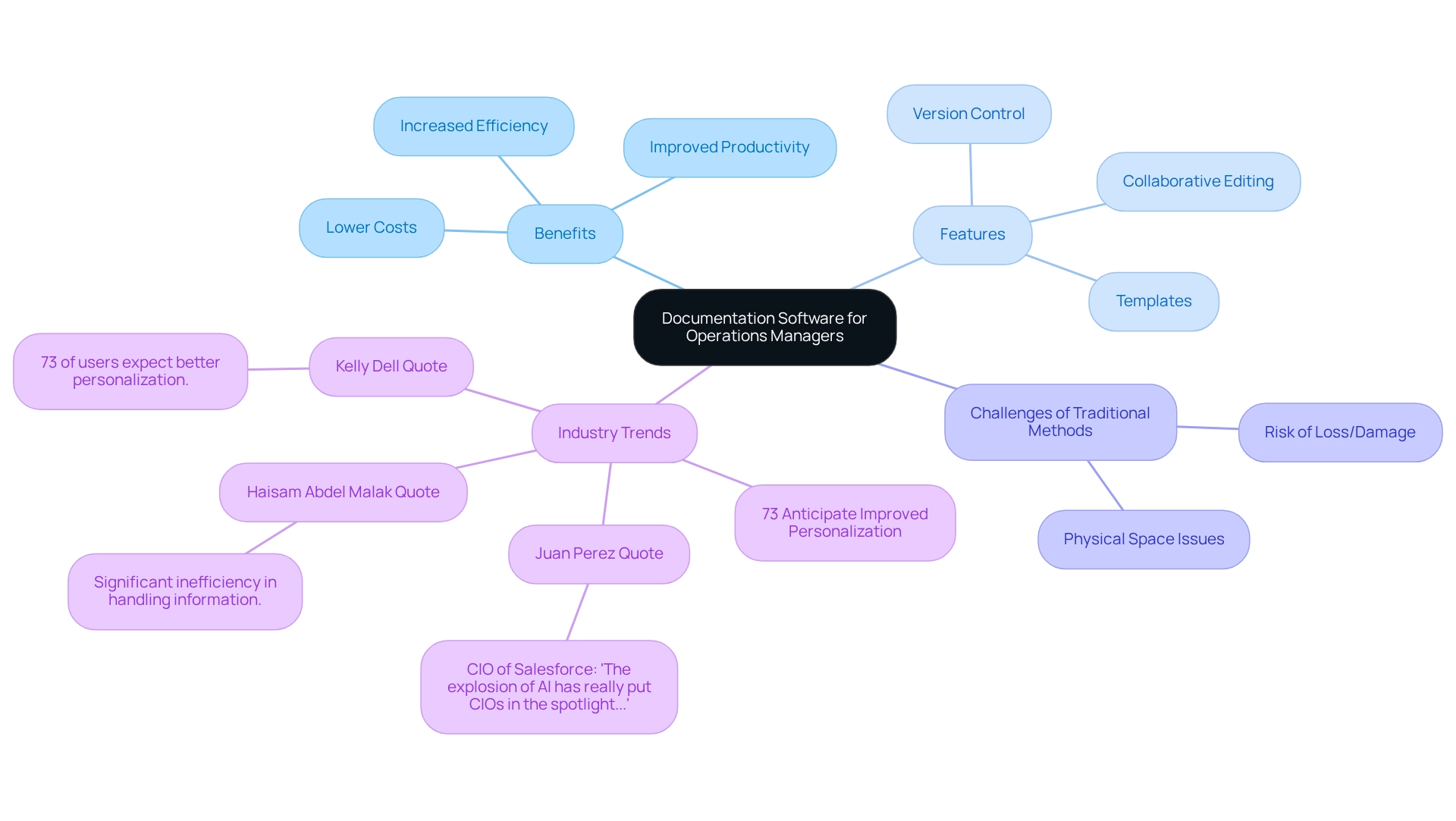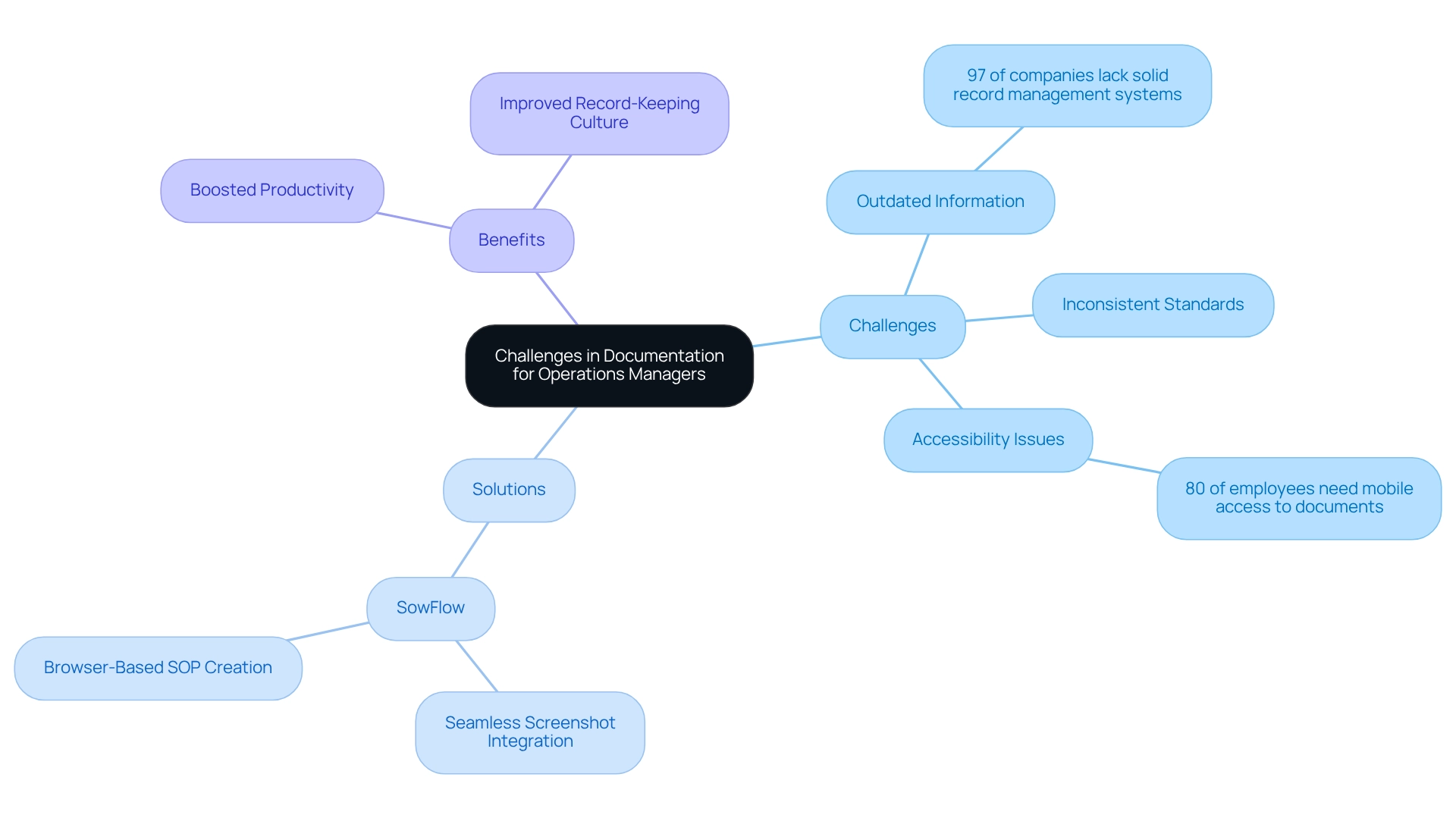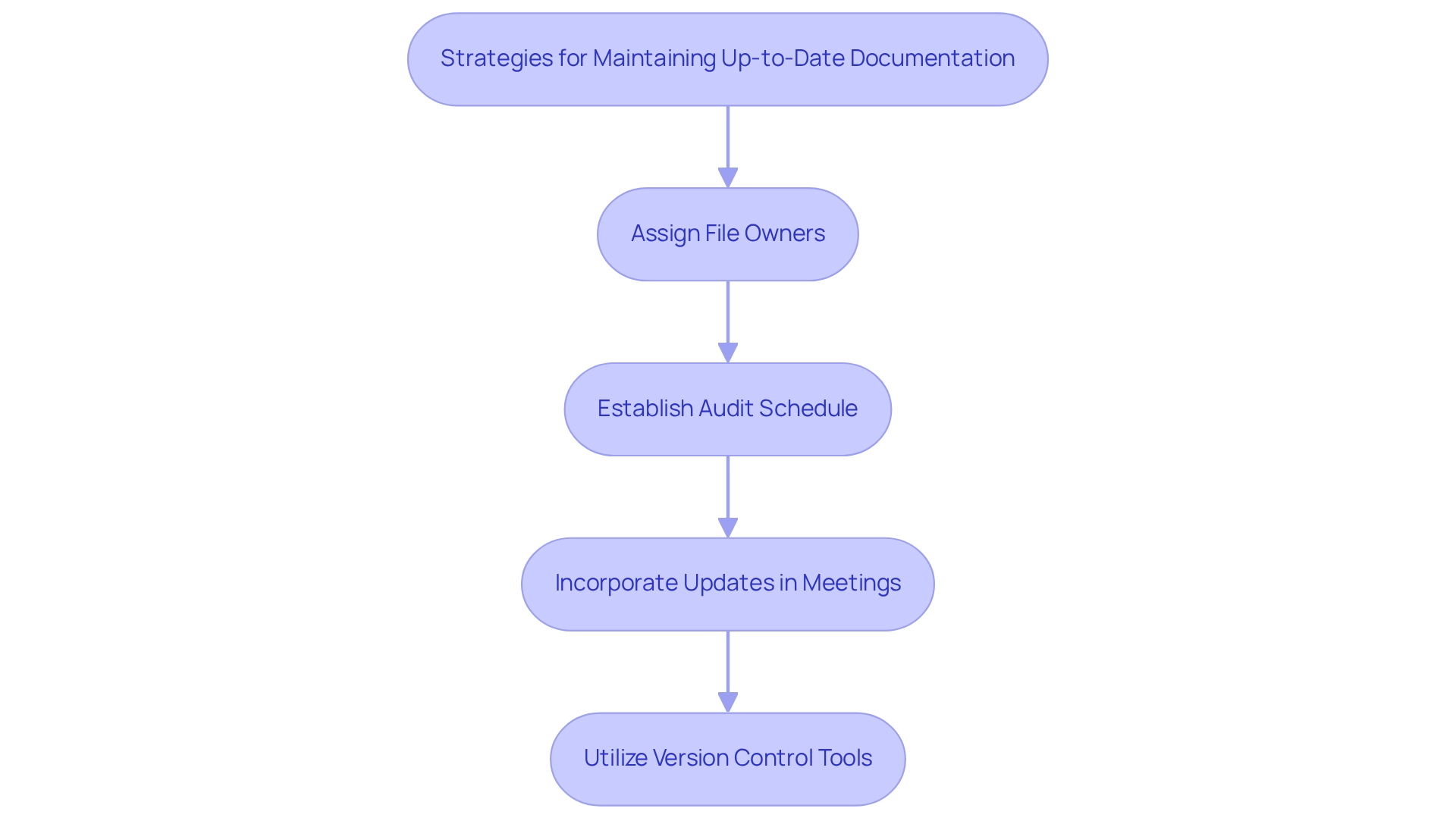
Streamlined Onboarding Processes
|
October 17, 2025
|
Best Practices for Using Documentation Software: Tips for Operations Managers
Overview
You might be wondering what the best practices are for using documentation software. Well, it’s all about:
- Creating standardized procedures
- Keeping things updated regularly
- Providing tailored training
This approach can really boost operational efficiency for managers! Now, here’s the exciting part: transitioning to digital solutions can significantly ramp up productivity and cut down onboarding times. Plus, embracing new technologies like AI can streamline those documentation processes. So, why not explore these options to make your workflow smoother?
Key Highlights:
- Documentation software is crucial for operations managers, aiding in the creation, management, and tracking of business documents.
- 97% of companies operate with minimal or no records management systems, highlighting the need for effective documentation solutions.
- Switching from paper to digital systems can increase efficiency by 47%, improving customer experience and attracting new clients.
- Outdated methods like email and paper records pose risks and inefficiencies for small and midsize businesses.
- Standardized procedures and centralized storage enhance productivity and reduce onboarding times for new employees.
- Regular audits and feedback loops are essential for maintaining relevant and useful records.
- Training programs should be tailored to different user levels to maximize the effectiveness of documentation software.
- AI and automation are transforming documentation processes, allowing teams to focus on strategic initiatives.
- Mobile-friendly documentation solutions are increasingly necessary as 80% of employees need mobile access to documents.
- Embracing new technologies and trends in documentation can significantly boost operational efficiency and security.
Introduction
In the dynamic world of operations management, you might be wondering just how important effective documentation really is. Well, it’s pretty crucial! As businesses aim for better efficiency and smoother processes, documentation software steps in as a game-changer, transforming how organizations handle their critical information. Did you know that a staggering 97% of companies are missing out on robust document management systems? That’s a clear sign that the time to adopt innovative solutions is now! By tapping into the power of documentation software, operations managers can boost productivity and foster a culture of collaboration and continuous improvement within their teams. So, let’s dive into the essential aspects of documentation software, exploring how it enhances operational efficiency, tackles common challenges, and implements best practices for lasting success.
Understanding Documentation Software: A Key Tool for Operations Managers
You might be wondering how documentation software can really help operations managers. Well, it’s a game-changer! This software is essential for creating, managing, and keeping track of important business documents. With features like templates, version control, and collaborative editing, it really boosts your workflow. In fact, did you know that 97% of firms say they have minimal or no records management systems? That just shows how much we need effective solutions!
By tapping into the functionalities of documentation software, you can pick the tools that fit your organization’s needs best. This not only ramps up productivity but also ensures everyone on your team has the latest information at their fingertips. For instance, companies that have made the switch from paper to digital systems report that 47% see increased efficiency, which is great for customer experience and attracting new clients.
Now, let’s talk about a case study that sheds light on the issues faced by businesses still relying on email and paper records. Many small and midsize companies are stuck in the past with these outdated methods, which take up a lot of physical space and come with risks of loss or damage. Switching to can really streamline your processes, improve accessibility, and strengthen business continuity, giving you that competitive edge.
As highlighted in the case study, moving away from traditional methods can seriously boost your operational efficiency. Current trends show that operations managers are starting to recognize the importance of documentation software in their daily tasks. Juan Perez, the CIO of Salesforce, said it best: 'The surge of AI has truly put CIOs in the spotlight and positioned them in the hot seat like never before.' This really emphasizes how technology is changing the game for record-keeping. Plus, Kelly Dell pointed out that "73% of users anticipate improved personalization after the rise of Generative AI applications," which underscores the need for operations managers to stay in the loop with the latest tech developments to keep their operations running smoothly.
In conclusion, the right documentation software can completely change how you manage business workflows. It helps in creating standard operating procedures (SOPs) and ensures that your records stay relevant in a fast-paced business world. Companies that have transitioned to digital documentation also mention perks like lower printing costs and better self-service experiences, which just highlights the value of these tools.

The Role of Documentation in Enhancing Operational Efficiency
You might be wondering how documentation software can really make a difference in your operations. Well, it’s essential for boosting efficiency! By setting clear guidelines and standardized procedures, teams can cut down on misunderstandings and save a ton of time when training new employees. Plus, having a centralized storage for files means quick access to vital information, which speeds up decision-making and ultimately boosts productivity.
Operations managers should really think about developing comprehensive documentation software that reflects current practices and is easy for everyone to access. Did you know that 97% of companies operate with minimal or no record management processes? That’s a huge area ripe for improvement! Switching to digital file management systems can streamline operations, enhance accessibility, and strengthen business continuity—especially for small and midsize enterprises (SMEs). It’s surprising how many organizations still rely on email for file storage, leading to inefficiencies and higher costs.
Speaking of that, a case study pointed out the challenges of depending on . By implementing specialized management solutions, these companies can not only improve their competitive edge but also promote sustainable practices through AI-driven algorithms that simplify creating, editing, sharing, and storing files.
Haisam Abdel Malak puts it perfectly when he says, "Printing, storing, and managing paper documents take up valuable time and office space." This really highlights why organizations should transition to digital solutions like documentation software. Experts agree that having standardized procedures can transform employee training and boost overall group productivity.
Operations managers have noticed that efficient records not only shorten onboarding times but also help teams collaborate better. For instance, organizations that adopt standardized procedures often see a big jump in productivity because employees can quickly refer to established guidelines instead of wasting time in lengthy meetings.
In conclusion, prioritizing records isn’t just a best practice; it’s a strategic must for operations managers who want to enhance efficiency and cultivate a culture of continuous improvement within their teams.
Common Challenges Operations Managers Face in Documentation
Operations managers, have you ever found yourself drowning in paperwork? You're not alone! Many face challenges like outdated information, inconsistent standards, and accessibility issues. Did you know that a whopping 97% of companies lack solid record management systems? This only makes things tougher. Plus, with 80% of employees needing to access documents on mobile devices, the need for is more urgent than ever.
You might be thinking, "Why is record-keeping so hard?" Well, traditional methods can be a real drag, often leading to employee reluctance in maintaining accurate records. To turn this around, operations managers should create a culture that values record-keeping as a key to organizational success. Imagine implementing user-friendly documentation systems like SowFlow, which can really boost efficiency. It makes it a breeze for teams to create and update records without those annoying delays.
Speaking of SowFlow, its features—like seamless screenshot integration and browser-based SOP creation—make recording processes a walk in the park. As Anastasia Masadi, a Product Owner, puts it, "SowFlow has been a game changer in the way we document work and deliver to our clients. I do not have to take each screenshot separately, and do not even have to leave the browser while I am creating SOPs and training materials. SowFlow gave me time from my life back."
Now, let’s dive into why regular audits and feedback loops are essential. They help identify areas that need improvement, ensuring your records are always relevant and useful. By taking advantage of SowFlow's advanced features, operations managers can boost productivity and keep their teams in the loop about various projects and workflows. Tailoring record-keeping solutions to fit your organization's specific needs can lead to a more organized approach, ultimately enhancing efficiency and reducing chaos in operations.
In summary, tackling those pesky record-keeping challenges requires a proactive mindset. Cultivating a supportive culture, using documentation software like SowFlow, and consistently refining processes are all steps in the right direction. Plus, with American businesses consuming around 21 million tons of paper each year, moving towards digital solutions is not just smart—it's essential. Want to see the magic of SowFlow for yourself? Book a demo today!

Best Practices for Implementing Documentation Software Effectively
To effectively implement documentation software for record-keeping, you might be wondering where to start. Well, operations managers should kick things off by setting clear objectives that align with their organizational goals. Choosing the right resources is key; for instance, SowFlow's documentation software gives teams immediate access to user manuals, supports smooth workflow sharing, and cuts down on unnecessary meetings by providing quick answers to common questions. Unlike other options like Document 360 and ProProfs, SowFlow makes it a breeze to create and update documents, which really boosts productivity and simplifies business analytics.
Now, let’s talk about training sessions—they're crucial for ensuring everyone on the team knows how to use the software. Effective training can significantly reduce the 23% efficiency loss that organizations often face due to . Plus, establishing a consistent format for documentation is essential for keeping things clear and accessible. This practice not only organizes information but also makes onboarding new hires easier and helps product teams explain their software solutions more effectively.
Regularly reviewing and updating documents is just as important to keep the information fresh and relevant in our fast-paced business world. Speaking of teamwork, promoting collaboration among team members can lead to more detailed records and a better understanding of processes. Case studies, like those tackling the hurdles of going paperless, reveal challenges such as regulatory issues and resistance to change. By keeping stakeholders informed and advocating for user-friendly interfaces, organizations can overcome these obstacles and foster a culture of efficient record-keeping.
SowFlow's documentation software is designed to tackle these challenges head-on, offering a streamlined way to create and manage written materials while ensuring compliance and ease of use.
Incorporating insights from successful operations managers really underscores the value of these practices. As Marina Coelho puts it, 'Effective records can be the key to success for a team.' This shows that records don’t have to be overly complex; they should focus on capturing essential information efficiently to save time down the line.
By following these best practices, operations managers can leverage SowFlow's documentation software to boost productivity and streamline their processes. Plus, user reviews really highlight how SowFlow has transformed their record-keeping methods, reinforcing the software's effectiveness in real-world applications.
Maintaining Up-to-Date Documentation: Strategies for Success
Keeping your records up to date? It takes a proactive and organized approach! You might be wondering how to make this happen. Well, operations managers can really benefit from assigning specific team members as file owners. This not only clarifies who’s responsible but also fosters a culture of diligence in record-keeping.
Now, let’s talk about audits. Establishing for reviewing records is key to spotting outdated information and making timely updates. Did you know that a recent survey found 48% of employees struggle to find files quickly? That’s a clear sign that we need better management strategies! Plus, when you have efficient record-keeping practices, you can avoid financial losses, boost productivity, reduce environmental impact, and even enhance collaboration within your team.
How about incorporating updates into your regular group meetings? This approach underscores the importance of keeping records fresh and ensures everyone is on the same page. And speaking of tools, utilizing version control features in documentation software is a game changer. It allows teams to track changes and maintain a detailed history of revisions, which is crucial for accountability and transparency. SowFlow can really help here, whether by creating materials for your organization or providing software solutions for self-management, helping teams optimize their writing processes.
By adopting these expert strategies, operations managers can build a solid framework for keeping records current. This not only leads to better collaboration but also reduces operational chaos. So, are you ready to take your record-keeping to the next level?

Integrating Documentation into Daily Operations: A Practical Approach
You might be wondering how to make record-keeping a breeze in your daily tasks. Well, operations managers can really help by encouraging team members to jot down activities as they happen. Using documentation software like SowFlow is key here—it allows for real-time updates and easy access, making integration a cinch. For instance, designing templates for common tasks can really streamline your record-keeping routine, ensuring consistency and cutting down on time spent on repetitive tasks.
Now, let’s talk about mindset. It’s super important to foster a culture where records are seen as valuable tools for improvement rather than just another chore. This shift can inspire employees to engage more actively in the documentation process. By regularly highlighting the perks of thorough documentation—like boosted efficiency and better customer experiences—you can reinforce its significance in hitting those operational goals.
As Anastasia Masadi, a Product Owner, put it, "SowFlow has been a game changer in the way we record work and deliver to our clients." She loves that she doesn’t have to take each screenshot separately or even leave her browser while creating SOPs and training materials. SowFlow has truly given her time back in her life!
This testimonial really drives home how SowFlow empowers teams to whip up SOPs and training materials on the fly, enhancing overall efficiency with features like real-time updates and easy template creation. And here’s a fun fact: statistics show that 47% of companies that have digitalized gained new clients thanks to improved efficiency. This underscores how effective record-keeping can boost business growth by enhancing customer experiences.
Speaking of enhancements, Haisam Abdel Malak noted, "The typical office employee utilizes 10,000 sheets of paper annually," which highlights the ecological benefits of reducing paper use through digital records. Plus, case studies reveal that 80% of employees need mobile access to documents to do their jobs well, making robust documentation software essential, especially in our remote work world.
By combining real-time record-keeping practices with tools like SowFlow, operations managers can keep their teams nimble and responsive to changes. This ultimately leads to a more structured and scalable operational framework. So, why not dive in and explore how these tools can transform your documentation game?
Training Your Team: Ensuring Effective Use of Documentation Tools
Training is a key piece of the puzzle when it comes to using software like SowFlow effectively. You might be wondering how to get started—well, operations managers should really focus on crafting a solid training program that includes hands-on workshops, detailed tutorials, and ongoing support. Customizing training sessions for different user levels is super important; this way, everyone, from newbies to seasoned pros, can feel confident using the software like a champ.
SowFlow makes it easy for teams to access materials right away, which means user guides can be developed quickly and updates can happen with just a simple command. This feature is a game-changer, allowing users to tap into their resources effortlessly and making that much better. Plus, creating a knowledge base or FAQ section can be a big win, giving team members quick answers and resources right at their fingertips.
Let’s not forget the value of encouraging feedback during those training sessions! It’s a great way to pinpoint where extra support might be needed.
Did you know that 34% of employees admit to skimming through compliance info? This really highlights the need for training programs that are not just effective but engaging, too. Practical workshops, for instance, have shown they can boost retention and application of knowledge, making them a must-have in any software training toolkit.
Industry experts stress the importance of tailored training programs. One leader put it perfectly: "Embrace the strength of records and observe the change it brings to your business in 2025 and beyond." This really emphasizes how well-structured training can impact organizational performance and help employees grow.
With ongoing compliance challenges being a reality for many businesses, regular and proactive training is essential. It helps minimize risks and ensures that employees are ready to uphold standards and protect the organization. A case study on compliance and security training shows that many companies face ongoing challenges, which reinforces the need for continuous training to tackle these issues effectively. By investing in smart training strategies, operations managers can foster a culture of continuous improvement and ensure their teams are all set to make the most of SowFlow's resources.
And here's a thought: implementing key strategies and metrics to maximize the ROI of employee training can really take these programs to the next level. It’s also wise to develop a strategy for competency development and individual learning plans to keep training aligned with both organizational goals and employee needs.
The Future of Documentation: Embracing New Technologies and Trends
The terrain of record-keeping is shifting fast, thanks to advances in technology like artificial intelligence, automation, and collaborative tools. You might be wondering how this affects you as an operations manager. Staying in the loop with these trends is key to effectively weaving them into your record-keeping practices. For example, AI-driven tools are getting really good at automating those routine documentation tasks, which means your team can shift their focus to more strategic initiatives.
Speaking of teamwork, collaborative platforms are a game changer! They promote better collaboration and knowledge sharing, breaking down those pesky barriers that often slow productivity.
Did you know that organizations that have digitized their information processes report a significant boost in efficiency? In fact, 47% say this shift has helped them attract new clients by enhancing the overall customer experience. Plus, implementing structured information management systems not only makes information more accessible but also streamlines workflows and boosts collaboration across teams. According to the Archive Corporation, four out of five employees need to access files on their mobile devices for work, which highlights the importance of mobile-friendly solutions.
Now, let’s dive into the future! Experts predict that AI's role in record-keeping will keep growing, especially when it comes to to protect sensitive information. As organizations tackle the challenges of digital transformation, the importance of robust security measures in records can’t be stressed enough. Case studies show that companies adopting these technologies can see a return on investment ranging from one to three times their IDP investment within the first year, mainly due to labor cost savings and improved operational efficiency.
Furthermore, evolving security concerns highlighted in recent studies underscore the need for advanced access controls to safeguard sensitive content from data breaches. By embracing these technological advancements proactively, you can ensure your documentation processes remain not only efficient but also relevant in today’s ever-changing business landscape.
Conclusion
You might be wondering just how crucial documentation software is in operations management. Well, it’s a game changer! This kind of software boosts productivity, encourages teamwork, and makes processes smoother. Did you know that a whopping 97% of companies are still struggling without effective document management systems? That’s a huge chance for improvement! By embracing innovative documentation solutions, organizations can tackle common issues like outdated information and inconsistent standards, making documents easier to access.
Now, let’s talk about best practices for documentation. Not only do they help keep records fresh, but they also foster a culture of continuous improvement among teams. And with tech advancements like AI and collaborative platforms, documentation processes become even more efficient. This means teams can spend less time on boring tasks and more on strategic initiatives. As operations managers tap into these advancements, they’re likely to see big boosts in operational efficiency and customer satisfaction.
So, in a nutshell, adopting documentation software proactively is key for organizations aiming to excel in today’s fast-paced business world. By focusing on effective documentation practices and using the right tools, operations managers can build a strong framework that supports growth, innovation, and a competitive edge in their fields. The time to act is now—embracing these changes will not only lead to lasting success but also create a more organized and efficient workplace.
Frequently Asked Questions
How does documentation software help operations managers?
Documentation software is essential for creating, managing, and tracking important business documents. It boosts workflow with features like templates, version control, and collaborative editing.
What percentage of firms lack effective records management systems?
97% of firms report having minimal or no records management systems, indicating a significant need for effective solutions.
What are the benefits of switching from paper to digital documentation systems?
Companies that transition to digital systems report a 47% increase in efficiency, which enhances customer experience and helps attract new clients.
What challenges do businesses face when relying on email and paper records?
Many small and midsize companies using outdated methods encounter issues like physical space constraints and risks of loss or damage to documents.
How can digital document management systems improve business operations?
Digital systems streamline processes, improve accessibility, strengthen business continuity, and provide a competitive edge.
What is the impact of technology, such as AI, on documentation practices?
Technology is changing record-keeping significantly, with operations managers recognizing the importance of documentation software to stay current and improve efficiency.
What advantages do companies experience from implementing documentation software?
Companies benefit from lower printing costs, better self-service experiences, and the ability to create standard operating procedures (SOPs) that keep records relevant.
How does documentation software affect employee training and productivity?
Clear guidelines and standardized procedures help reduce misunderstandings, save time during training, and improve collaboration, leading to increased productivity.
Why is prioritizing records management important for operations managers?
Prioritizing records management enhances efficiency and fosters a culture of continuous improvement within teams, which is crucial for operational success.
👍
What others are liking
5 Steps to outline your ideal documentation structure
5 MINS READ
Where to start the your journey of mapping out your ideal documentation structure, aligning it with the very heartbeat of your organization?
Defining a winning level of detail in your process
3 MINS READ
What is too much detail, and what is too little? This article described in that winning level detail about what detail is enough.





